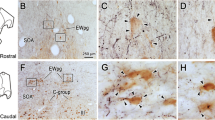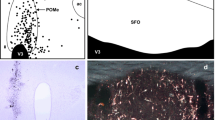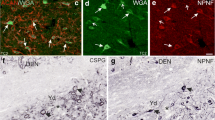Abstract
A neuronal pathway from the nucleus prepositus hypoglossi (PH) to the superior colliculus (SC) has been documented in previous studies using retrogradely transported tracer methods. This pathway may underlie a feedback control of gaze-related collicular activities. The present study provided a detailed description of this pathway in the cat using the Phaseolus vulgaris-leucoagglutinin technique. Two axonal trajectories exist that depend on the location of injections into the PH. As described in previous studies, injections within the caudal PH labelled axons that ran through the contralateral side and terminated in the contralateral SC (cSC). Injections in the rostral PH labelled axons ascending in the midbrain on the ipsilateral side and ending within both colliculi – mostly in the rostral SC on the ipsilateral side and over a large rostrocaudal extent on the contralateral side. A quantitative analysis of the density of synaptic terminal boutons was done in three out of six cats which revealed that, independently of axonal trajectories, the density of boutons increased from rostral to caudal in the cSC. Thus the preposito-collicular projection is weighted along the rostrocaudal axis of the cSC. From this result, a simulation was done in order to examine how excitatory sensory activities and a topographically weighted inhibitory feedback might interact within collicular networks. This simulation was able to mimic electrophysiological data obtained in the cat and in the monkey that showed that the motor error is topographically coded over the collicular map. Present results give a strong morphological support for a temporal-to-spatial transformation of feedback signals related to eye movement parameters.
Similar content being viewed by others
Author information
Authors and Affiliations
Additional information
Received: 1 May 1996 / Accepted: 29 October 1996
Rights and permissions
About this article
Cite this article
Corvisier, J., Hardy, O. Topographical characteristics of preposito-collicular projections in the cat as revealed by Phaseolus vulgaris-leucoagglutinin technique. A possible organisation underlying temporal-to-spatial transformations. Exp Brain Res 114, 461–471 (1997). https://doi.org/10.1007/PL00005655
Issue Date:
DOI: https://doi.org/10.1007/PL00005655




